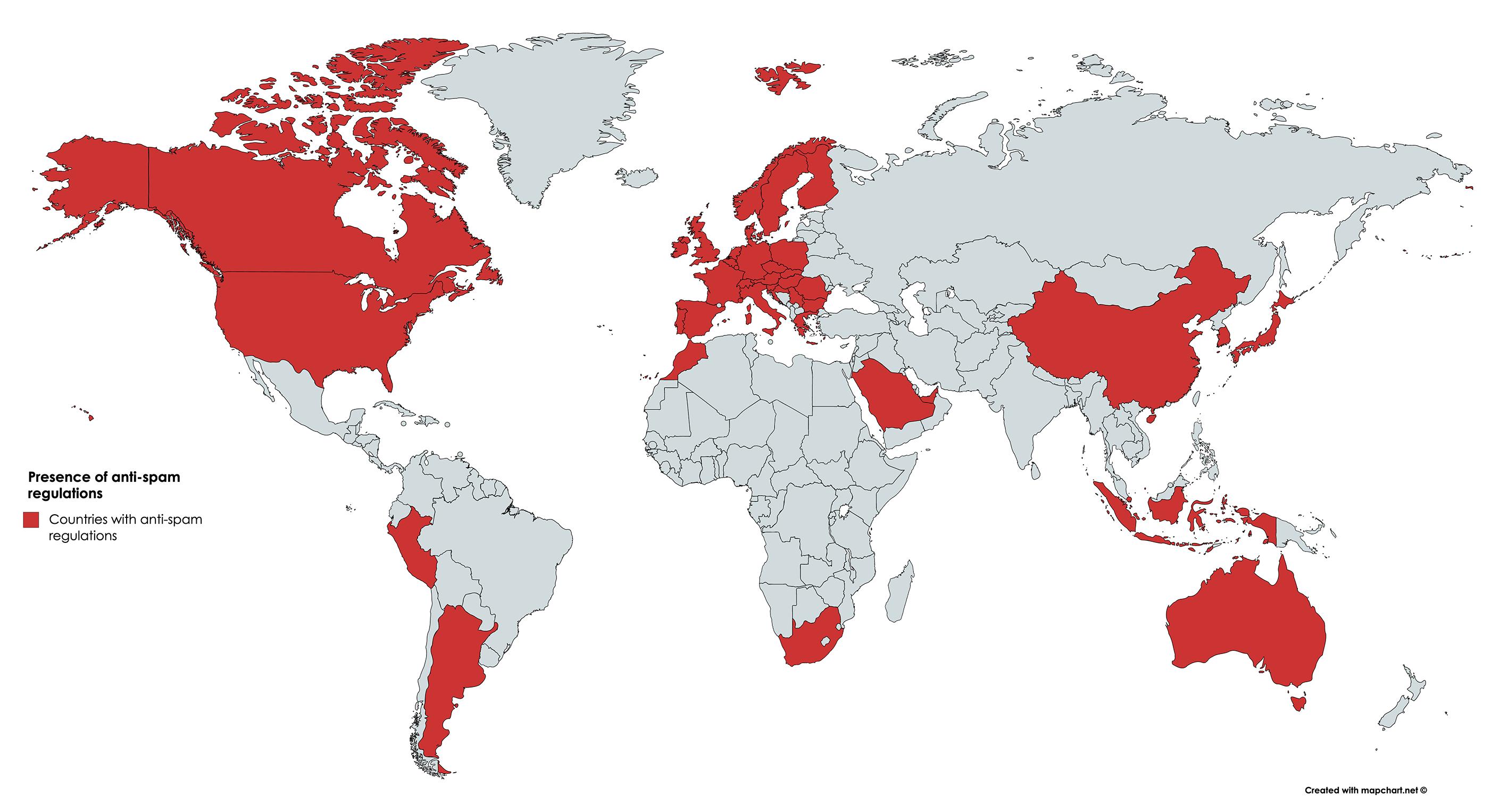As you grow your mailing list you may gain subscribers from different countries. Or you may be expanding your business into new regions.
In any case, if you’re an international email marketer, it is important that you stay up-to-date with anti-spam regulations. New regulations are being proposed and made into law all the time. So here’s a brief overview of what you need to know and look out for.
Which countries have anti-spam laws?
Many countries have anti-spam laws. The more well-known legislations are the EU’s General Data Protection Legislation (GDPR) and the USA’s Controlling the Assault of Non-Solicited Pornography and Marketing Act (CAN-SPAM). Both are often used as guidelines by other countries.
Identifying anti-spam regulations can be tricky. Especially when some countries, such as Canada and South Africa, have multiple policies relating to marketing and data protection. And some European countries have their own set of laws in addition to the GDPR.
So it’s always recommended that you do your own research to find out the relevant marketing regulations for your country and specific audience.
To help you out, here’s a map of countries that have anti-spam regulations.

Regulations can vary significantly by country and are sometimes covered by general legislation on all telecommunications, including SMS. Also, regulations are not always strongly enforced, even when they are present.
For example, countries such as Brazil and India lack legislation that specifically targets senders. So it is hard to determine the liability of spammers and take legal action.
As internet access and online marketing increases, data protection and spam are a constant legal challenge for legislators. So many countries are creating and amending their laws to protect internet users. And that’s why it is important to stay informed on any changes that may impact your business.
Do subscribers need to opt-in?
Opting-in is an essential part of all spam regulations. It means subscribers have to agree to receive marketing emails before you send them. However, opt-ins can come in many forms.
There are two main types of opt-in: a soft opt-in and a hard opt-in. A soft opt-in is when you gain the recipient’s personal details through a business interaction. And then you send them an email. For example, if someone makes a purchase on your website, you can assume they are interested in your products and send them more promotional material.
A hard opt-in is when the recipient subscribes to your mailing list using a specific opt-in form. And Germany and Switzerland take it one step further by requiring new subscribers to double opt-in by entering their details and checking a box to confirm.
they know what they are signing up for and expect to receive.
How can subscribers provide consent?
Getting new subscribers to consent when opting in ensures that you can legally send the them emails.
Providing consent means giving subscribers a choice on whether they want to receive emails from you or not. And it means they should be able to refuse or withdraw consent.
In some countries, consent can be implied when an individual has provided their email address from a previous business interaction, such as making a purchase from your website.
However, under the GDPR, consent needs to be made explicit. This means that terms of consent need to be explicitly expressed in written form. Individuals do not have write or type out their consent. But they do need to indicate that they agree to the terms by ticking a box or signing their name.
A ‘grey area’ for consent is when opt-in forms are partially filled in, such as a pre-checked opt-in box. This means the subscriber would have to un-check the box if they did not agree to the terms.
Pre-checked opt-in boxes are currently banned in a number of countries, including:
- Canada
- Australia
- Netherlands
- European countries under the GDPR
However, in other countries opting-in is not even a requirement. For example, the US’s CAN-SPAM Act only requires senders to give their subscribers the opportunity to opt-out of receiving emails.
How does opting-out work?
The majority of anti-spam regulations and laws require senders to give their mailing list members the option to unsubscribe or opt-out. And the process should be made clear in emails and be easy to do.
However, countries do differ on how long a request to opt-out needs to take effect, as you can see:
- Australia – 5 work days
- Spain – 10 days
- Singapore – 10 days
- USA & Canada – 10 work days
- UK – 28 days
- The Netherlands – 30 days
- Germany, France, Italy – As reasonable
With a range of five days to a month, it is best to ensure that opt-out requests are carried out quickly to avoid complaints or being identified as spam.
What else needs to be in your email?
Anti-spam regulations can also be specific on what they require a sender to include in their emails. For example, some regulations legally require businesses to include their postal address or contact information.
Again, this varies by country. But here’s a round up of the regulations for a few countries:

Anti-spam regulations are becoming increasingly important as legislators want to ensure users are protected and prevent spam.
As email marketers, you must follow the relevant laws and guidelines. And you can find more information on email marketing regulations around the world on our Github repository.
* At EmailOctopus, as per our terms and conditions, we require that all senders ensure that their recipients have opted-in to receiving emails.





No Comments
Leave a comment Cancel